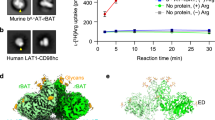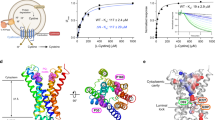Summary
Cystinuria, one of the most common genetic disorders, is characterized by excessive excretion of cystine and basic amino acids in urine. The low solubility of cystine results in formation of kidney stones which can eventually lead to renal failure. Three types of cystinurias have been described. All involve defects in a high-affinity transport system for cystine in the brush border membranes of kidney and intestinal epithelial cells. The molecular properties of proteins involved in epithelial cystine transport are incompletely understood. A protein (NBAT, neutral and basic amino acid transporter), initially cloned by us from rat kidney and shown to be localized in the renal and intestinal brush border membranes, has been implicated in this transport, and mutations in human NBAT gene have been found in several cystinurics, making it a prime candidate for a cystinuria gene. However, mutations in NBAT were found only in Type I cystinurics and not in Types II and III suggesting that defects in other, as yet uncharacterized, genes may also be involved. NBAT has an unusual (for an amino acid transporter) membrane topology. We proposed that the protein contains four membrane-spanning domains, a model disputed by other investigators. We subsequently obtained experimental data consistent with a four membrane-spanning domain model. Furthermore, recently we showed that kidney and intestinal NBAT (85kDa) is associated with another brush border membrane protein (about 50kDa) and have proposed that the heterodimer represents the minimal functional unit of the high-affinity cystine transporter in these membranes. These findings raise the tantalizing possibilities that defects in the NBAT-associated protein might account for cystinurias in individuals with normal NBAT gene (such as the Types II and III cystinurics).
Similar content being viewed by others
References
Baldwin SA (1994) Mammalian Na+-independent sugar transporters and their homologues in other organisms. Cell Physiol Biochem 4: 242–264
Bertran J, Werner A, Stange G, Markovich D, Biber J, et al (1992) Expression cloning of a cDNA from rabbit kidney cortex that induces a single transport system for cystine and dibasic and neutral amino acids. Proc Natl Acad Sci USA 89: 5601–5605
Bertran J, Werner A, Chillaron J, Nunes A, Biber J, et al (1993) Expression cloning of a human renal cDNA that induces high affinity transport of L-cystine shared with dibasic amino acids inXenopus oocytes. J Biol Chem 268: 14842–14849
Bertran J, Testar X, Zorzano A, Palacin M (1994) A new age for mammalian plasma membrane amino acid transporters. Cell Physiol Biochem 4: 217–241
Brandl CJ, Deber CM (1986) Hypothesis about the function of membrane-buried proline residues in transport proteins. Proc Natl Acad Sci USA 83: 917–921
Busch AE, Herzer T, Waldegger S, Schmidt F, Palacin M, Biber J, Markovich D, Murer H, Lang F (1994) Opposite directed currents induced by the transport of dibasic and neutral amino acids inXenopus oocytes expressing the protein rBAT. J Biol Chem 269: 25581–25586
Calonge MJ, Gasparini P, Chillaron J, Chillon M, Gallucci M, et al (1994) Cystinuria caused by mutations in rBAT, a gene involved in the transport of cystine. Nature Genet 6: 420–425
Calonge MJ, Nadal M, Calvano S, Testar X, Zelante L, et al (1995a) Assignment of the gene responsible for cystinuria (rBAT) and of markers D2S119 and D2S177 to 2p16 by fluorescence in situ hybridization. Hum Genet 95: 633–636
Calonge MJ, Volpini V, Bisceglia L, Rousaud F, de Sanctis L, et al (1995b) Genetic heterogeneity in cystinuria: The SLC3A1 gene is linked to type I but not to type III cystinuria. Proc Natl Acad Sci USA 92: 9667–9671
Christensen HN, Albritton LM, Kakuda DK, MacLeod CL (1994) Gene-product designations for amino acid transporters. J Exp Biol 196: 51–57
Coady MJ, Jalal F, Chen X, Lemay G, Berteloot A, Lapointe J-Y (1994) Electrogenic amino acid exchange via the rBAT transporter. FEBS Lett 356: 174–178
Coicadan L, Heyman M, Grasset E, Desjeux JF (1980) Cystinuria: reduced lysine permeability at the brush border of intestinal membrane cells. Pediatr Res 14: 109–112
Dahlberg PG, Vandenberg CJ, Kurtz SB, Wilson DM, Smith LW (1977) Clinical features and management of cystinuria. Mayo Clin Proc 52: 533–542
Foreman JW, Hwang SM, Segal S (1980) Transport interactions of cystine and dibasic amino acids in rat renal tubules. Metabolism 29: 53–61
Furriols M, Chillaron J, Mora C, Castello A, Bertran J, et al (1993) rBAT, related to cystine transport is localized to the microvilli of proximal straight tubules and its expression is regulated in kidney by development. J Biol Chem 268: 27060–27068
Gasparini P, Calonge MJ, Bisceglia L, Purroy J, Dianzani I, et al (1995) Molecular genetics of cystinuria: identification of four new mutations and seven polymorphisms, and evidence for genetic heterogeneity. Am J Hum Genet 57: 781–788
Goodyear PR, Clow C, Reade T, Girardin C (1993) Prospective analysis and classification of patients with cystinuria identified in a newborn screening program. J Pediatr 122: 568–572
Kanner BI, Kleinberger-Doron N (1994) Structure and function of sodium-coupled neurotransmitter transporters. Cell Physiol Biochem 4: 174–184
Kilberg MS, Stevens BR, Novak DA (1993) Recent advances in mammalian amino acid transport. Annu Rev Nutr 13: 137–165
Lee W-S, Wells RG, Sabbag RV, Mohandas TK, Hediger MA (1993) Cloning and chromosomal localization of a human kidney cDNA involved in cystine, dibasic and neytral amino acid transport. J Clin Invest 91: 1959–1963
Levy HL, Madigan PM, Shih VE (1972) Massachusetts metabolic disorders screening program: I. Technics and results of urine screening. Pediatrics 49: 825–836
Magagnin S, Bertran J, Werner A, Markovich D, Biber J, Palacin M, Murer H (1992) Poly(A+) RNA from rabbit intestinal mucosa induces bo, + and y+ amino acid transport activities inXenopus laevis oocytes. J Biol Chem 267: 15384–15390
Markovich D, Stange G, Bertran J, Palacin M, Werner A, Biber J, Murer H (1993) Two mRNA transcripts (rBAT-1 and rBAT-2) are involved in system b0,+-related amino acid transport. J Biol Chem 268: 1362–1367
McKusick VA (1994) Cystinuria. In: Mendelian inheritance in man, 11th edn. The Johns Hopkins Press, Baltimore, pp 1751–1752
McNamara PD, Pepe LM, Segal S (1981) Cystine uptake by renal brush border vesicles. Biochem J 194: 443–449
McNamara PD, Rea CT, Segal S (1992) Ion dependence of cystine and lysine uptake by rat renal brush border membrane vesicles. Biochim Biophys Acta 1103: 101–108
Miyamoto K, Katai K, Tatsumi S, Sone K, Segawa H, et al (1995) Mutations of the basic amino acid transporter gene associated with cystinuria. Biochem J 310: 951–955
Mosckovitz R, Udenfriend S, Felix A, Heimer E, Tate SS (1994) Membrane topology of the rat kidney neutral and basic amino acid transporter. FASEB J 8: 1069–1074
Mosckovitz R, Yan N, Heimer E, Felix A, Tate SS, Udenfriend S (1993) Proc Natl Acad Sci USA 90: 4022–4026
Nirenberg MJ, Tate SS, Mosckovitz R, Udenfriend S, Pickel VM (1995) Immuno-cytochemical localization of the renal neutral and basic amino acid transporter in rat adrenal gland, brainstem, and spinal cord. J Comp Neurol 355: 1–18
Ozegovic B, McNamara PD, Segal S (1982) Cystine uptake by rat jejunal brush border membrane vesicles. Biosci Rep 2: 913–920
Palacin M (1994) A new family of proteins (rBAT and 4F2hc) involved in cationic and zwitterionic amino acid transport: A tale of two proteins in search of a transport function. J Exp Biol 196: 123–137
Pickel VM, Nirenberg MJ, Chan J, Mosckovitz R, Udenfriend S, Tate SS (1993) Ultrastructural localization of a neutral and basic amino acid transporter in rat kidney and intestine. Proc Natl Acad Sci USA 90: 7779–7783
Pras E, Arber N, Aksentijevich I, Katz G, Schapiro JM, et al (1994) Localization of a gene causing cystinuria to chromosome 2p. Nature Genet 6: 415–419
Pras E, Raben N, Golomb E, Arber N, Aksentijevich I, Schapiro JM, et al (1995) Mutations in the SLC3A1 transporter gene in cystinuria. Am J Hum Genet 56: 1297–1303
Rosenberg LE, Durant JL, Holland IM (1965) Intestinal absorption and renal extraction of cystine in cystinuria. N Engl J Med 273: 1239–1345
Schafer JA, Watkins ML (1984) Transport of L-cystine in isolated perfused proximal straight tubules. Pflugers Arch 401: 143–151
Segal S, Thier SO (1989) Cystinuria. In: Scriver CH, Beudet AL, Sly WS, Valle D (eds) The metabolic basis of inherited diseases. McGraw-Hill, New York, pp 2479–2496
Segal S, McNamara PD, Pepe LM (1977) Transport interaction of cystine and dibasic amino acids in renal brush border vesicles. Science 197: 169–171
Sharland M, Jones M, Bain M, Chalmers R, Hammond J, Patton MA (1992) Balanced translocation (14:20) in a mentally handicapped child with cystinuria. Med Genet 29: 507–508
Tate SS, Yan N, Udenfriend S (1992) Expression cloning of a Na+-independent neutral amino acid transporter from rat kidney. Proc Natl Acad Sci USA 89: 1–5
Thier S, Fox M, Segal S, Rosenberg LE (1964) Cystinuria: in vitro demonstration of a intestinal transport defect. Science 143: 482–484
Uhl GR, Hartig PR (1992) Transporter explosion: update on uptake. Trends Pharmacol Sci 13: 421–425
Van Winkle LJ, Campione AL, Gorman MJ (1988) Na+-independent transport of basic and zwitterionic amino acids in mouse blasocysts by a shared system and by processes which distinguish between these substrates. J Biol Chem 263: 3150–3163
Wang Y, Tate SS (1995) Oligomeric structure of a renal cystine transporter: implications in cystinuria. FEBS Lett 368: 389–392
Weingberger A, Sperling O, Rabinovitz M, et al. (1974) High frequency of cystinuria among Jews of Libyan origin. Hum Hered 24: 568–572
Wells RG, Hediger MA (1992) Cloning of a rat kidney cDNA that stimulates dibasic and neutral amino acid transport and has sequence similarity to glucosidases. Proc Natl Acad Sci USA 89: 5596–5600
Yan N, Mosckovitz R, Udenfriend S, Tate SS (1992) Distribution of mRNA of a Na+-independent neutral amino acid transporter cloned from rat kidney and its expression in mammalian tissues andXenopus laevis oocytes. Proc Natl Acad Sci USA 89: 9982–9985
Yan N, Mosckovitz R, Gerber LD, Mathew S, Murty VVVS, Tate SS, Udenfriend S (1994) Characterization of the promoter region of the gene for the rat neutral and basic amino acid transporter and chromosomal localization of the human gene. Proc Natl Acad Sci USA 91: 7548–7552
Zhang X-X, Rozen R, Hediger MA, Goodyer P, Eydoux P (1994) Assignment of the gene for cystinuria (SLC3A1) to human chromosome 2p21 by fluorescence in situ hybridization. Genomics 24: 413–414
Author information
Authors and Affiliations
Rights and permissions
About this article
Cite this article
Tate, S.S. Evidence suggesting that the minimal functional unit of a renal cystine transporter is a heterodimer and its implications in cystinuria. Amino Acids 11, 209–224 (1996). https://doi.org/10.1007/BF00813861
Received:
Accepted:
Issue Date:
DOI: https://doi.org/10.1007/BF00813861




